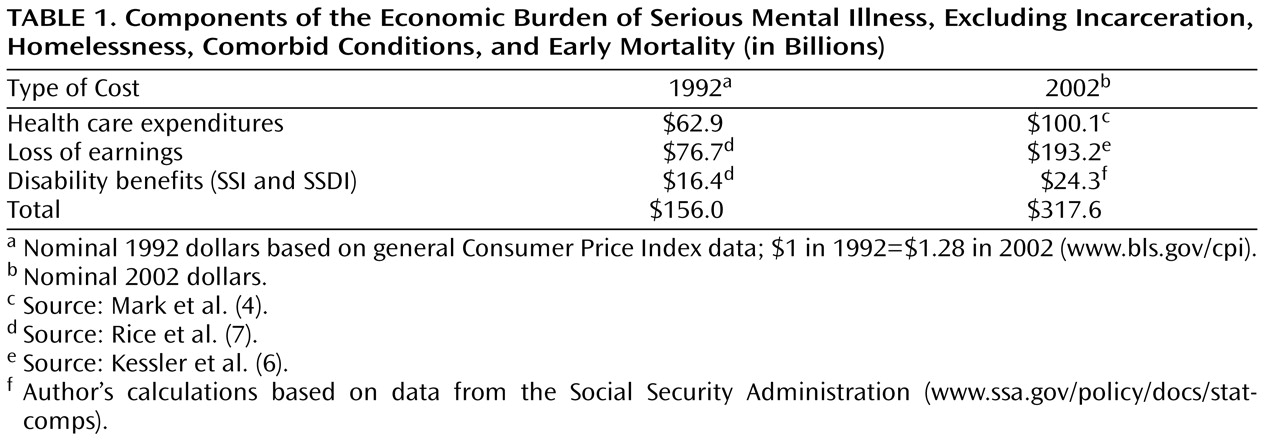It goes without saying that the excess costs of untreated or poorly treated mental illness in the disability system, in prisons, and on the streets are part of the mental health care crisis. We are spending too much on mental illness in all the wrong places. And the consequences for consumers are worse than the costs for taxpayers.
Michael F. Hogan (1)
What do mental disorders cost the nation? The costs of health care are considered one of the greatest challenges in U.S. public policy
(2) . In 2006, health care costs reached 16% of the nation’s gross domestic product, on a path to reach 20% by 2016
(3) . While mental disorders contribute to these costs at an estimated 6.2% of the nation’s spending on health care
(4), the full economic costs of mental disorders are not captured by an analysis of health care costs. Unlike other medical disorders, the costs of mental disorders are more “indirect” than “direct.” The costs of care (e.g., medication, clinic visits, or hospitalization) are direct costs. Indirect costs are incurred through reduced labor supply, public income support payments, reduced educational attainment, and costs associated with other consequences such as incarceration or homelessness. Another kind of indirect cost results from the high rate of medical complications associated with serious mental illness, leading to high rates of emergency room care, high prevalence of pulmonary disease (persons with serious mental illness smoke 44% of all cigarettes in the United States), and early mortality (a loss of 13 to 32 years)
(5) . While indirect costs have been challenging to quantify, they are critical for informing public policy. Once we assess the key components of the economic burden of mental disorders, we can have a more informed discussion about what should be invested to prevent and treat these illnesses.
This issue of the
Journal includes an important report by Kessler et al.
(6) that focuses on one source of indirect costs: the costs from loss of earnings. The analysis is based on the National Comorbidity Survey Replication (NCS-R), a population-based epidemiological study of mental disorders. In this survey, data from nearly 5,000 individuals were used to estimate loss of earnings by comparing earnings in the previous 12 months of persons with mental disorders with 12-month earnings of persons without mental disorders. The analysis focused on individuals with serious mental illness. The results, based on a generalized linear model analysis, demonstrate a mean reduction in earnings of $16,306 in persons with serious mental illness (both with and without any earnings) and also that about 75% of the total reduction in earnings came from individuals who had some earnings in the prior year (versus those who did not have any earnings at all). By extrapolating these individual results to the general population, the authors estimated that serious mental illness is associated with an annual loss of earnings totaling $193.2 billion.
There are several surprises in this report. One is the gender difference in earnings: even when the earnings of men with serious mental illness dropped to $28,070 (compared with men without serious mental illness), these earnings were still higher than earnings in women without serious mental illness. This result cannot be explained by a large number of women outside of the workforce, because analysis of those subjects with positive earnings only demonstrated the same profound difference in earnings based on gender. A second unexpected finding is that the loss of earnings is not mainly a function of chronic unemployment. Finally, when one extends these findings to the general population, the financial loss is considerably larger than previous estimates
(7,
8), which seems only partly explained by inflationary considerations.
While $193.2 billion seems enormous, it is important to recognize that the NCS-R yields a conservative sample for estimating economic impact. As a door-to-door survey, NCS-R did not assess individuals hospitalized in institutions, incarcerated in prisons or jails, or who are homeless. Indeed, NCS-R had so few subjects with schizophrenia or autism that these diagnoses were not part of the original epidemiological analysis, even though both are associated with chronic disability and lifelong loss of income on a far greater per capita basis than mood or anxiety disorders.
Accepting this conservative estimate of a loss of $193.2 billion in earnings each year from serious mental illness, can we estimate the total economic impact of serious mental illness? In
Table 1 we begin to answer this question, adding the new estimates of income loss to data from 2002 on the direct costs of health care and disability benefits, including Social Security Disability Insurance (SSDI) and Supplemental Security Income (SSI) cash assistance, food stamps, and public housing financed by federal and state revenues. Missing are the costs of health care for comorbid conditions. Missing are estimates for the loss of productivity due to premature death and the loss of productivity of those with serious mental illness who are institutionalized, incarcerated, or homeless. Missing is the cost of incarceration, although as many as 22% of individuals in jails and prisons have been diagnosed with mental illness
(9) . Missing is the cost of homelessness, although approximately one third of adult homelessness is associated with serious mental illness
(8) . And, of course, missing from any such tabulation is the cost to family members who bear much of the emotional and financial burden of these illnesses. The $317 billion estimated economic burden of serious mental illness in
Table 1 excludes costs associated with comorbid conditions, incarceration, homelessness, and early mortality, yet this sum is equivalent to more than $1,000/year for every man, woman, and child in the United States.
A little more than 5 years ago, Dr. Michael Hogan, chair of the President’s New Freedom Commission on Mental Health, noted that “we are spending too much on mental illness in all the wrong places”
(1) . This is even more true in 2008 than in 2002. The costs of social services for persons with these chronic, disabling illnesses will likely continue to climb. The questions we must ask ourselves are not new, but they remain urgent: How can we ensure that mental health care is cost-efficient as well as effective for patients? How will we reduce homelessness, job loss, and incarceration? And perhaps most importantly, how much should we invest in disseminating effective treatments and finding better treatments in order to reduce these costs?


